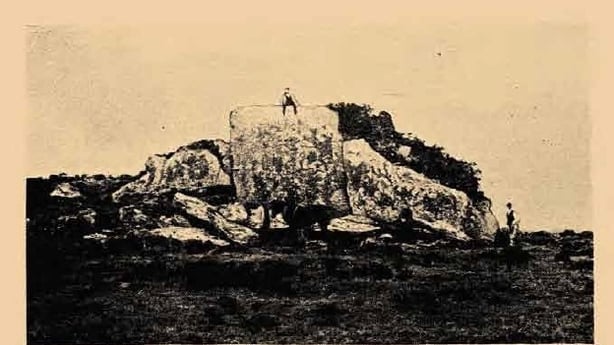Analysis: a rock in Co Cork in closely associated with many legends around Chlíodhna and is known as a door to the Otherworld
Special rocks and ancient sacred stones feature prominently in Early Irish literature and in legends. Some are linked to the sovereignty queen tradition where goddesses are connected with particular clans and areas. "At the regional and local level", writes Gearóid Ó Crualaoich in The Book of the Cailleach: Stories of the Wise-Woman Healer, "the divine female represents the sovereignty principle in respect of more localized dynastic identity, as for example, in the case of the O'Brien dynasty of Thomond in North Munster (Aoibheall) and the O’Keeffe dynasty of East and North Cork (Clíodna)."
Clíodhna, whose name may mean "the territorial one", is also associated with Cork’s McCarthy family line, to whom she is said to have passed the secret of the Blarney Stone, which is now housed at Blarney Castle, built by Cormac MacCarthy in the 15th century.
"The goddess Clíodna together with Aoibhell and Áine constitutes a triad of Munster goddesses", with links to the banshee", explains Daragh Smyth in Earthing the Myths: The Myths, Legends and Early History of Ireland. It’s referenced in a story that "there is no morning of the year when Clíodhna isn’t outside of that Carraig before sunrise, combing her hair", an activity associated with the banshee.
We need your consent to load this rte-player contentWe use rte-player to manage extra content that can set cookies on your device and collect data about your activity. Please review their details and accept them to load the content.Manage Preferences
From RTÉ Archives, Prof Patricia Lysaght talks about the banshee on The Late Late Show. with Gay Byrne in 1986
Indeed, Clíodhna is also regarded as the banshee that rules as queen over the fairies of south Munster. Patricia Lysaght explains that "the association of the death-messenger with a former land goddess who is now a bean sí is again evident in Clíona, territorial goddess of south-Munster, and as such intimately connected with important families and individuals in the area".
Carraig Chlíodhna (Clíodhna’s Rock), anglicized as the placename Carrigcleena, is seven miles southwest of Mallow in the parish of Kilshannig and is known as a "door to the Otherworld". Another rock, Carrigcleenamore, off Inch Strand, two miles southeast of Rosscarbery is traditionally known as the seat of this goddess and door to the underworld.
The Kilshannig rock, where "Clíodhna’s síd or fairy palace is close to" and where "she was said to reside in a palace under" features in the story about Seán Mac Séamais, son of an Irish king. After he eats a slice of apple Chlíodhna gives him during a dance, she enchants and abducts him, physically trapping him inside the rock and simultaneously in the otherworld. He writes a letter in blood, throwing it into the wind. A cowherd finds it, alerting the king who gets help from a wise-woman. The wise-woman’s daughter goes to the rock and twists a handful of Clíodhna’s hair in such a way that Clíodhna cannot look at her, since her mother warned:"if she lays her eyes on you, you're finished", and frees Seán.

Clíodhna is described as one of three daughters of Gebann, the chief druid of the sea-god Manannán Mac Lir. She is known for guarding against blighted crops and protecting animals, particularly cattle, from disease and from the evil eye. In legends, Clíodhna possesses three birds which feed on an otherworldly apple-tree and which possess magical singing powers that heal people.
Clíodhna herself is credited with powers including the ability to shapeshift into a wren or a large white rabbit. "According to local lore in north Cork, Clíona was many times seen leading the fairies in a nocturnal dance at her conspicuous rock". Known as the "Queen of the Munster Fairies", her appearance is specifically associated with inside the stone circle nearby her rock.
The 12th century Book of Leinster has Clíodhna falling in love with Aonghus who lives at Newgrange in Co. Meath. She sails from her otherworldly dwelling Magh Meall ("Pleasant Plain") to be with him. The musician Iuchna plays treacherous magical music that puts her to sleep at Cuan Dor or Glandore ("Harbour of the Oak Trees") between Skibbereen and Clonakilty where she is drowned by a great wave. Because of the way she was treated, Clíodna threatened to cause a very large wave which would completely cover Munster.
As with many so-called "fairy places", this one is a dynamic part of the local environment.
A variant story has her leaving Tír Tairngire ("Land of Promise") to travel with her human lover, Ciabhán. When they land at Trá Théite, Glandore harbour, he goes hunting, leaving her sleeping in his boat where she is drowned by a massive wave. One of three great flood-waves of Ireland (as designated in an ancient topographical system) thus gets its name as Tonn Clíodhna (Chlíodhna’s Wave), mentioned in the Dindshenchas ("lore of places"). This association, as Dáithí Ó hÓgáin explains, "was an expression of the idea that the deities resided in, and that goddesses were patronesses of, water".
Residents of Carrigcleena, Bweeng, near Mallow have told me that Chlíodhna’s Rock is an important part of the landscape. Local woman Elizabeth says "it's a big part of our local area. If I go for a walk on my break, I'll say I am just walking as far as the Rock", adding that both locals and visitors go and sit at the rock: "We have visitors who come from far and wide to visit the rock; they attend to it, keeping it tidy. They sit with the rock absorbing its healing power". Monica, who lives close by, says she’d be "devastated" if anything happened to the rock. As with many so-called "fairy places", this one is a dynamic part of the local environment.
The views expressed here are those of the author and do not represent or reflect the views of RTÉ




